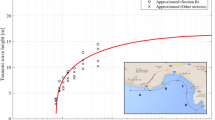Abstract
This study presents a tsunami human damage prediction method employing numerical calculation and GIS (Geographical Information System) for Usa town, Tosa City, Shikoku Island, Japan. Sometime near the end of the first half of the twenty-first century, a huge earthquake is predicted to occur along the Nankai trough and costal areas facing the Pacific ocean of Shikoku Island. Much damage due to the resultant tsunamis will be caused, therefore, it is necessary to predict the extent of human damage for every town in high-risk areas.
The number of tsunami victims was estimated by population in areas of maximum inundation. The number of deaths as a result of tsunami was estimated by a method which employed accumulated death toll of every area in terms of time and space, taking into account consideration of time necessary to begin to seek refuge after an earthquake, tsunami inundation depth on land, flow velocity and evacuation speed. As a result of this study a rapid decrease in death toll by early evacuation was shown quantitatively for the first time.
Thus, with the method presented here, it is possible to estimate the extent of tsunami human damage on coastal regions, and may be useful as a tsunami human damage countermeasure.
Similar content being viewed by others
References
Hatori, T.: 1978, Monuments of the Nankaido Tsunamis of 1605, 1707 and 1854 in the Shikoku District: Behavior of Historical Tsunamis and their Comparison with the 1946 Nankaido Tsunami, Bull. Earthq. Res. Inst., Vol. 53, University of Tokyo Earthquake Research Institution, pp. 423–445.
Hori, T. and Oike, K: 1996, A statistical model of temporal variation of seismicity on the inner zone of southwest Japan related to the Great Interplate Earthquake along the Nankai Trough, J. Phys. Earth 44, 349–356.
Kawata, Y.: 1997, Prediction of loss of human lives due to catastrophic earthquake disaster, J. Nat. Dis. Sci. 16(1), 3–13.
Kotani, M., Imamura, F., and Shuto, N.: 1998, Tsunami run‐up simulation and damage estimation by using GIS, Proceeding of Costal Engineering, Vol. 45, Japan Society of Civil Engineers, pp. 356–360.
Murakami, H., Shimada, T., Ito, S., Yamamoto, N., and Ishizuka, J.: 1996a, Reexamination of the Heights of the 1605, 1707 and 1854 Nankai Tsunamis along the Coast of Shikoku Island, J.JSNDS, Vol. 15, No. 1, Japan Society for Natural Disaster Science, pp. 39–52.
Murakami, H., Ito, S., Yamamoto, N., and Sato, H.: 1996b, Consideration of Tsunami Risk on The coastal area in Kii Peninsula and Shikoku Island, Proceeding of Costal Engineering, Vol. 43, Japan Society of Civil Engineers, pp. 316–320.
Regional Data for Disaster Prevention, Regional Evacuation Edition: 1987, Institute for Fire Safety & Disaster Preparedness, pp. 91–96. (in Japanese)
Sato, R.: 1989, Japanese Earthquake Fault Parameter Handbook, Kajima Institute Publishing, 133 pp (in Japanese).
Shimada, T., Murakami, H., Kozuki, Y., Sugimoto, T., and Nishikawa, K.: 1999, Estimation of loss of lives due to tsunami disasters, Proceeding of Costal Engineering, Vol. 46, Japan Society of Civil Engineers, pp. 361–365.
Takahashi, S., Endo, H., and Muro, Z.: 1992, The safety of human on amenity breakwater at wave overtopping, Proceeding of Costal Engineering, Vol. 39, Japan Society of Civil Engineers, pp. 721–725 (in Japanese).
Yamamoto, N., Murakami, H., Kozuki, Y., and Gotoda, T.: 1998, Tsunami disaster prevention based on analysis of questionnaires in Shikoku Island, Proceeding of Costal Engineering, Vol. 45, Japan Society of Civil Engineers, pp. 381–385 (in Japanese).
Author information
Authors and Affiliations
Rights and permissions
About this article
Cite this article
Sugimoto, T., Murakami, H., Kozuki, Y. et al. A Human Damage Prediction Method for Tsunami Disasters Incorporating Evacuation Activities. Natural Hazards 29, 587–602 (2003). https://doi.org/10.1023/A:1024779724065
Issue Date:
DOI: https://doi.org/10.1023/A:1024779724065




